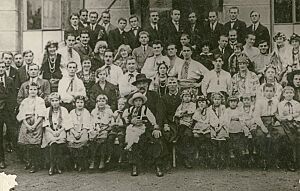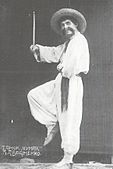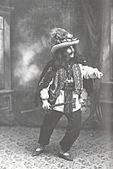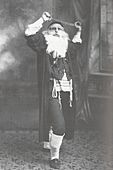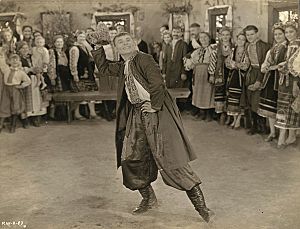Vasyl Avramenko facts for kids
Vasyl Kyrylovych Avramenko (Ukrainian: Василь Кирилович Авраменко) was a Ukrainian artist born on March 22, 1895, who became famous for spreading Ukrainian folk dance around the world. He was an actor, dancer, and even a film producer! Many people call him the "Father of Ukrainian Dance" because he worked so hard to share his love for Ukrainian culture.
Contents
Vasyl's Early Life and Discovering Dance
Vasyl Avramenko was born in a small town called Stebliv, about 100 kilometers south of Kyiv. He became an orphan when he was young and had to travel far, even across Russia to Siberia, to find his older brothers in Vladivostok. There, his oldest brother taught him to read and write. This helped Vasyl get a job at a naval base, which allowed him to visit many different cities in Asia. These travels made him want to learn even more!
He eventually became a primary school teacher. In 1912, while in Vladivostok, Vasyl saw a play called Natalka Poltavka. This was the first time he saw Ukrainians performing on stage, and it really inspired him.
Later, during World War I, Vasyl joined the Russian Imperial Army. He was wounded and ended up in a hospital. While recovering, he got involved with a group of military actors and realized he loved being on stage.
Learning and Teaching Ukrainian Dance
In the summer of 1917, Vasyl Avramenko went to special classes in Kyiv taught by Vasyl Verkhovynets. These classes were all about Ukrainian folk dance, how to choreograph it, and how to perform it on stage. Verkhovynets' ideas, based on his theater training and research of village dances, greatly inspired Avramenko. He took many notes on Ukrainian dances and steps, which became the foundation for his life's work.
By 1919, Avramenko was performing with theater groups. During a time of conflict, he was arrested and held in a camp in Kalisz. In February 1921, he started a Ukrainian folk dancing school right there in the camp! This was the first of more than 100 schools he would open over the next 20 years across Europe and North America. He taught everyone, from guards to small children, showing them that Ukrainian folk dancing could be a beautiful art form. He started with 100 students and put on a big performance in May.
Later that year, he met Oleksandr Koshyts, a famous conductor, who was amazed by Avramenko's dance performance. Avramenko became very popular and began touring with his students through western Ukraine. He gave demonstrations and workshops, encouraging others to learn and teach his dances. His tours visited many cities like Lviv, Rivne, and Ternopil between 1922 and 1924.
Bringing Ukrainian Dance to North America
In December 1925, Avramenko arrived in Halifax, Canada. He had a big goal: to tour North America with dancers, singers, and musicians to show the world the Ukrainian people and their culture.
Most Ukrainians in Canada lived in the prairie provinces. Avramenko decided to start in Toronto, opening his first dance school in North America. He offered lessons for all ages, from preschoolers to adults. His school helped students feel proud of their Ukrainian heritage. His dance group first performed at the Canadian National Exhibition (CNE) in 1926, for huge crowds of up to twenty-five thousand people! News about Avramenko appeared in many newspapers, both Ukrainian and English.
In January 1927, Avramenko arrived in Winnipeg. His group performed, and he soon opened another school. By April, Avramenko and 275 of his students performed at Winnipeg's large amphitheater, a place usually used for hockey games.
- Depictions of Avramenko Dances
Avramenko and his students quickly set up schools across the Canadian prairies, in cities like Saskatoon, Yorkton, and Edmonton. They had strong support from the Ukrainian-Canadian community. He taught the same dances in each town and then assigned a leader to continue teaching. One of these leaders, Chester Kuc, later founded the famous Ukrainian Shumka Dancers.
In 1928, Avramenko moved to New York City. He opened a school in "Little Ukraine" in Manhattan, and soon had over 500 students. He wanted to bring Ukrainian dance to a wider audience, beyond just the Ukrainian community. He even staged a big performance at the Metropolitan Opera with 500 dancers, 100 singers, and an orchestra, all in Ukrainian costumes. The New York Evening Post praised it as a "brilliant Ukrainian folk festival."
Avramenko as a Movie Producer
By October 1933, Avramenko was in Hollywood. He wanted to make films to promote Ukrainian culture. He gathered support and money from Ukrainian immigrants across the country. He even claimed he turned down a role in a Hollywood film because the dances would be called "Russian" instead of "Ukrainian."
In 1935, his students from Baltimore performed at the White House Easter Egg Roll. Avramenko saw this as a victory for the Ukrainian cause.
Making Natalka Poltavka
Avramenko decided to produce a feature film based on the popular Ukrainian play, Natalka Poltavka. He believed it would bring fame to the Ukrainian cause. He started the Avramenko Film Company in New York City in 1936. He raised enough money, and a Hollywood film director named Edgar G. Ulmer joined the project.
Ulmer put together a film crew and helped rewrite the script. The music was recorded in New York, and the film was shot on a farm in New Jersey. Ulmer said Avramenko was incredibly enthusiastic and inspiring. Even though the film was an artistic success, it left Avramenko with more debt because it was expensive to rent theaters to show it without a major distributor. However, it was the first Ukrainian language film made in the United States!
Making Cossacks in Exile
Because of the financial challenges from his first film, Avramenko went to Canada to raise money for his next movie, Cossacks in Exile. In September 1937, he announced the creation of the Ukrainian Film Corporation in Winnipeg. People in Canada loved his first film and didn't know about his financial troubles. Avramenko appealed to Ukrainian patriotism to sell rights to show the new film across different provinces.
Filming for Cossacks in Exile began in May 1938. Director Ulmer was happy with the film. Like the first film, it received great reviews. The New York Times even praised it as "highly agreeable." However, without a big distributor, the film had to be shown city by city, which was very costly.
Later Years and Legacy
For the rest of his life, Avramenko continued to show and sell his films. In 1954, he released a documentary called "The Triumph of Ukrainian Dance," which included parts of his earlier films.
After World War II, Avramenko continued to offer Ukrainian folk dancing courses in Canada. Many dance groups later developed, building on the foundation he helped create. These groups focused on keeping the spirit of folk dance alive.
In the 1960s, Avramenko also spent time in Australia, teaching dance at Ukrainian schools. Towards the end of his life, he organized special events to celebrate Ukrainian culture and his own achievements. Many of his former students, who were children when they first learned from him, helped him with these events. Vasyl Avramenko passed away on May 6, 1981, in New York City. He left behind a lasting legacy as the "Father of Ukrainian Dance," who brought this vibrant art form to the world.
|


